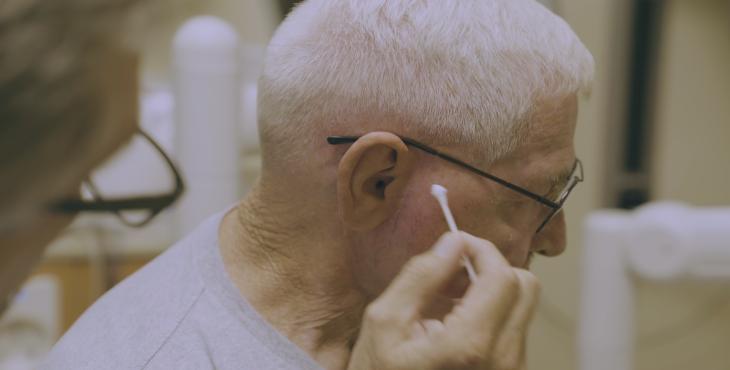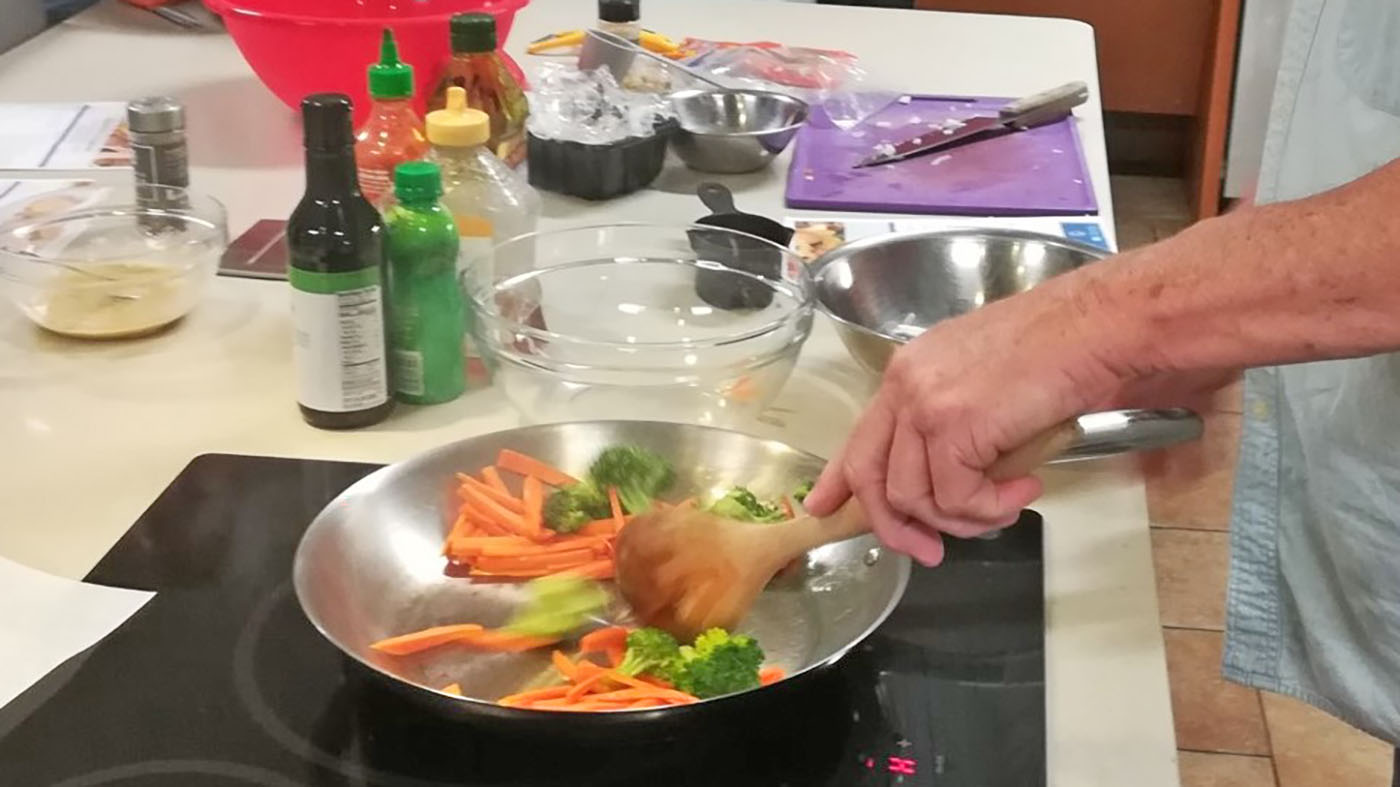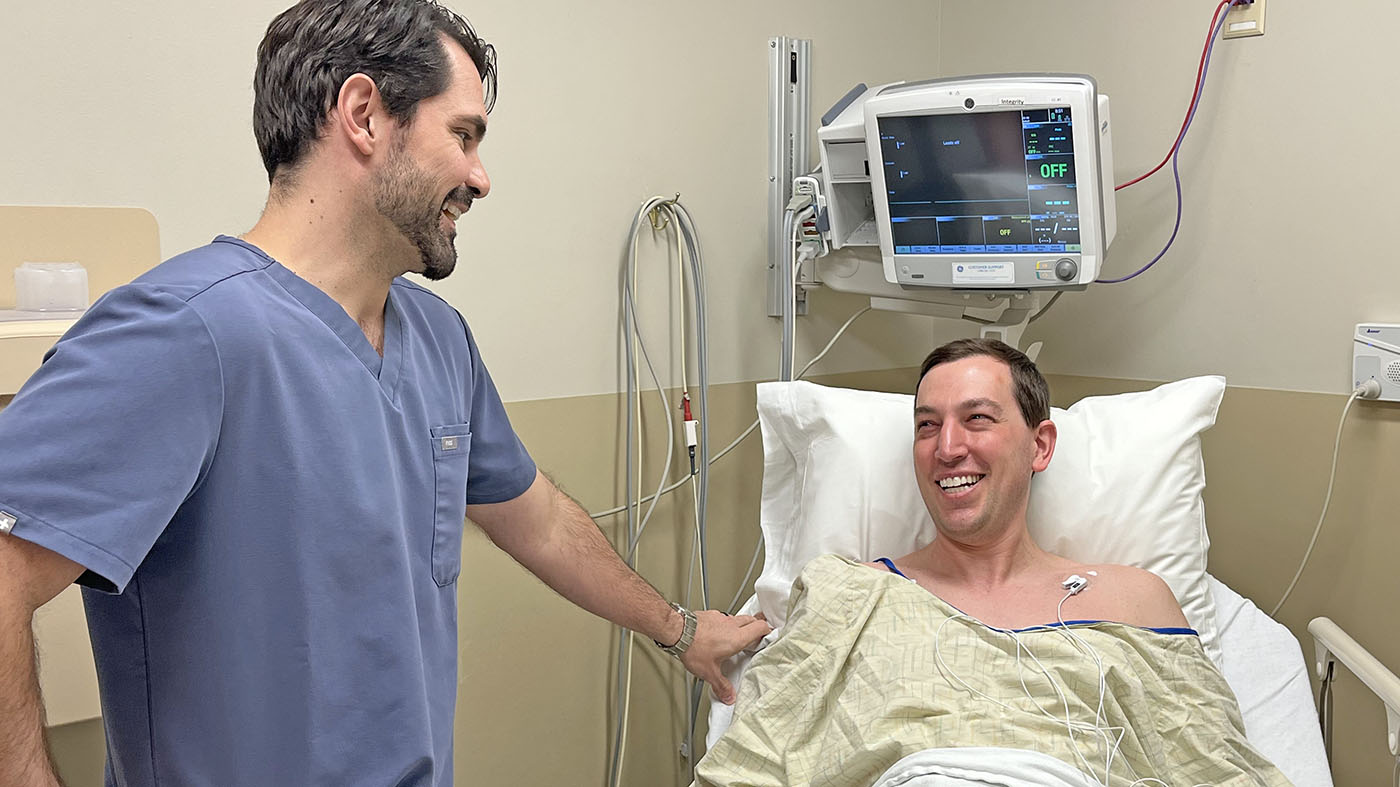While “lend me your ears” may have been written by Shakespeare in the 16th century, it came true in a literal sense for a Veteran.
Navy Veteran Robert Chesser received a new prosthetic ear, created for him by prosthetist David Trainer, to replace the ear he lost to cancer. The custom-made auricular prosthesis, as the silicone ear is more properly called, is one of many different prostheses Trainer has made for Veterans at James A. Haley Veterans’ Hospital over the last several years.
Chesser was first diagnosed with squamous cell cancer on his right ear about three years ago. Since then he has endured 15 operations, two rounds of radiation treatment and a round of chemotherapy. The first surgeries were done in an attempt to save his ear, but the spreading cancer forced doctors to complete remove his outer ear, leaving him with his hearing but also with a large hole on the side of his head where the ear used to be.
“I ended up with cancer in the whole ear area and down my jaw and my neck, the whole nine yards, and that’s when I lost the ear,” Chesser said. “They said, ‘That’s alright, never mind, they’ll fix you one up.’”
He was referred to the Dental Service, which works with Veterans like Chesser.
“We deal with restorations of head and neck cancer patients, both intraoral and extraoral (inside and outside the mouth) defects,” said Maxillofacial Prosthodontist Dr. Nicholas Goetz, who said he works primarily with patients needing restorations in the mouth. “There’s a lot of complex, large cases that I do, so David is able to come in here and do a great job for our patients with extraoral prostheses. They’re very time consuming, so it’s a great help for us.”
The 73-year-old Veteran had did have some problems that complicated and delayed the day he could receive his new ear. Radiation had weakened the bone structure in the part of his skull that would normally be used to place pins usually used to attach the ear, and the surgery left him with an area of exposed bone that prevented the use of a prosthesis.
Home treatments with homeopathic medicines helped bring skin back over the bone, while it was decided to use an adhesive to hold the prosthesis in place.
Trainer, who has been making prosthetic ears, noses and eyes for patients for 35 years, has worked with the VA for the last several years out of his office in Naples, Florida. He drives almost 170 miles each way for at least three visits with the patient before the final prosthesis is ready.
“On the first visit, I take an impression of both sides (including the left ear). With that I, then, I create models from which I sculpt the opposing ear for Mr. Chesser,” Trainer, who received his training in his native England, said. “I come back to the VA, I try that on, make sure it looks right, fits, everything is correct. Then I go back and I make a mold of that wax ear, then replace the wax with silicone. Then on the last visit I extrinsically paint it and fit it on the patient.”
While he spends and average of an hour-and-a-half with the patient on each visit, it will normally take him four to five hours to sculpt the wax ear, then another two days making the mold and the silicon ear. He uses medical grade silicon that can be left attached for days at a time with no ill effect for the patient.
For Chesser, Trainer brought three different silicone ears in different shades so he could most closely match the Veteran’ skin tone. Selecting one, he then laid out his paints and began the process of matching the patients skin tone, mottling and even vein structure found in his remaining ear.
Trainer, who said he is not artistic, “… but I can copy well,” Constantly checking the copy against the real ear, Trainer worked for more than an hour before he was satisfied that the copy was as close to the original as possible.
Using silicone adhesive to attach the prosthesis and petroleum jelly to smooth the edges. In the opinion of everyone in the room, it was almost impossible to tell the real ear from the prosthetic one, even to Chesser, who first put on his glasses and then sat looking at both ears in a hand mirror.
For Trainer, each person who receives one of his prostheses makes his day.
“It’s always a joy. For the last 35 years, I tend not to see people as patients. I call them my big happy family because you’re entering a very intimate part of their world,” Trainer said. “It’s something that they don’t want everybody to know about, so you’re forming a very close relationship with them, and as long as that person is happy at the end of the day, I’m very happy.”
Chesser, who said he’s maintained a positive outlook during his entire ordeal, seemed happy enough that he joked with his wife when the session was finished.
“I can’t wait until the day when she’s yelling at me, and I can take the ear off, lay it on the table, and tell here, ‘Talk to the ear.’”
Video produced by audiovisual production specialist Melvin Abrieu, of the James A. Haley Veterans’ Hospital.
Topics in this story
More Stories
VA promotes early nutrition intervention for chronic kidney disease with targeted programs like Heathier Kidneys Through Your Kitchen.
VA Research Advisory Committee on Gulf War Veterans’ Illnesses hosting Veteran Engagement Sessions in Phoenix for 1990-91 Gulf War Veterans.
Navy Veteran and president of the American Medical Association got a colonoscopy and encourages other Veterans to do the same.






